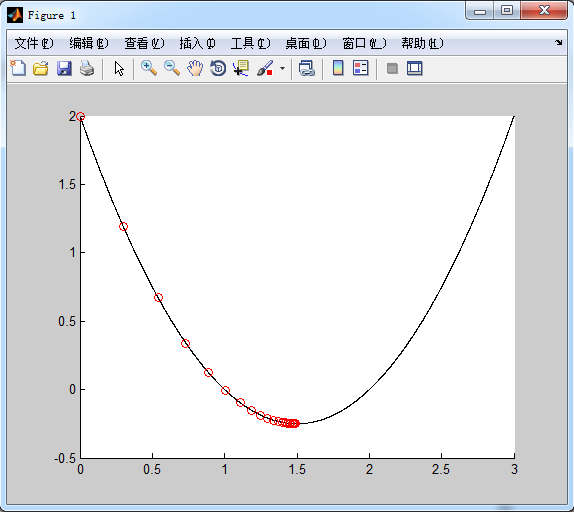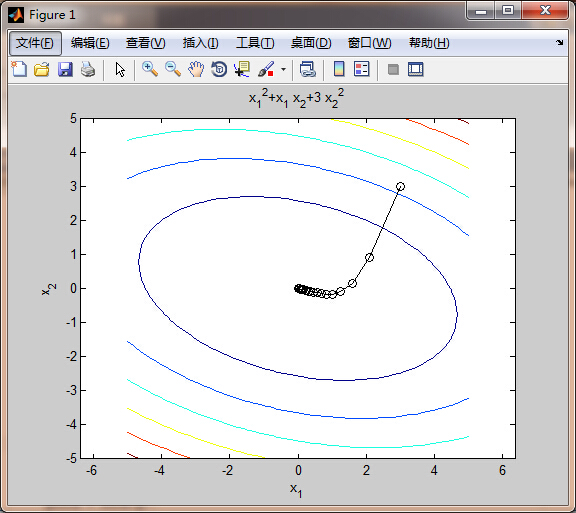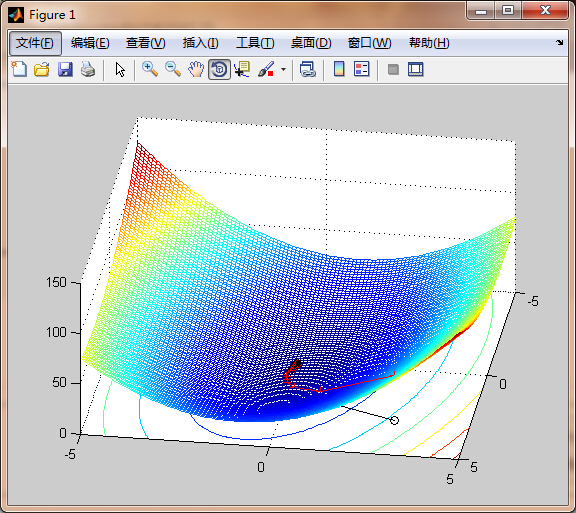Lesson 2 Gradient Desent
2016-07-10 14:35
369 查看
The goal is to find X such that minXf(X)
Using gradient descent algorithm to obtain the minimum value of the funtion.
let y=f(x)
Init: x=x0,y0=f(x0), iterative step α, convergent precision ϵ
The ith iterative formula can be expressed as:
xi=xi−1−α∇f(xi−1)
Example: solve the minimum of function f(x)=x2+3x+2
let x0=0, step \alpha = 0.1, convergent precision ϵ=10−4

let’s move into multi-variable case, say we have m samples, each sample has n features. X is expressed as: X=⎡⎣⎢⎢⎢⎢⎢xT1xT2⋮xTm⎤⎦⎥⎥⎥⎥⎥
where
xi=⎡⎣⎢⎢⎢⎢xi1xi2⋮xin⎤⎦⎥⎥⎥⎥
Then X can be denoted as :
X=⎡⎣⎢⎢⎢⎢⎢x11x21⋮xm1x11x21⋮xm1⋯⋯⋱⋯x1nx2n⋮xmn⎤⎦⎥⎥⎥⎥⎥
Assuming h(x.)=∑j=1najx.j=xT.a
Here, a=⎡⎣⎢⎢⎢⎢a1a2⋮an⎤⎦⎥⎥⎥⎥ is a unknown vector we need to solve.
Xa−y=⎡⎣⎢⎢⎢⎢⎢h(x1)−y1h(x2)−y2⋮h(xm)−ym⎤⎦⎥⎥⎥⎥⎥
Now the objective function is minaf(a)=12(Xa−y)T(Xa−y)
Before the derivation, I would like to introduce some facts:
tr(AB)=tr(BA) ………………………………..(1)
tr(ABC)=tr(BCA)=tr(CAB)………………………………..(2)
tr(A)=tr(AT) ………………………………..(3)
if a∈R, tr(a)=a………………………………..(4)
∇Atr(AB)=BT………………………………..(5)
∇Atr(ABATC)=CAB+CTABT………………………………..(6)
In order to obtain the critical points of f(a), we take the derivative of f(a) w.r.t a and set it to be zero.
∇af(a)∇af(a)=0=∇a12(Xa−y)T(Xa−y)=12∇a(aTXTXa−aTXTy−yTXa+yTy)=12∇atr(aTXTXa−aTXTy−yTXa+yTy)// the trace of a scalar is still a scalar=12(∇atr(aTXTXa)−∇atr(aTXTy)−∇atr(yTXa)+∇atr(yTy))=12(∇atr(aTXTXa)−∇atr(yTXa)−∇atr(yTXa)+∇atr(yTy))=12(∇atr(aTXTXa)−2XTy)=12(∇atr(aaTXTX)−2XTy)=12(∇atr(aIaTXTX)−2XTy)=XTXa−XTy=0
we can easily get a as follows:
a=(XTX)−1XTy


Using gradient descent algorithm to obtain the minimum value of the funtion.
let y=f(x)
Init: x=x0,y0=f(x0), iterative step α, convergent precision ϵ
The ith iterative formula can be expressed as:
xi=xi−1−α∇f(xi−1)
Example: solve the minimum of function f(x)=x2+3x+2
let x0=0, step \alpha = 0.1, convergent precision ϵ=10−4
f = @(x) x.^2 - 3*x + 2; hold on for x=0:0.001:3 plot(x, f(x),'k-'); end x = 0; y0 = f(x); plot(x, y0, 'ro-'); alpha = 0.1; epsilon = 10^(-4); gnorm = inf; while (gnorm > epsilon) x = x - alpha*(2*x-3); y = f(x); gnorm = abs(y-y0); plot(x, y, 'ro'); y0 = y; end

let’s move into multi-variable case, say we have m samples, each sample has n features. X is expressed as: X=⎡⎣⎢⎢⎢⎢⎢xT1xT2⋮xTm⎤⎦⎥⎥⎥⎥⎥
where
xi=⎡⎣⎢⎢⎢⎢xi1xi2⋮xin⎤⎦⎥⎥⎥⎥
Then X can be denoted as :
X=⎡⎣⎢⎢⎢⎢⎢x11x21⋮xm1x11x21⋮xm1⋯⋯⋱⋯x1nx2n⋮xmn⎤⎦⎥⎥⎥⎥⎥
Assuming h(x.)=∑j=1najx.j=xT.a
Here, a=⎡⎣⎢⎢⎢⎢a1a2⋮an⎤⎦⎥⎥⎥⎥ is a unknown vector we need to solve.
Xa−y=⎡⎣⎢⎢⎢⎢⎢h(x1)−y1h(x2)−y2⋮h(xm)−ym⎤⎦⎥⎥⎥⎥⎥
Now the objective function is minaf(a)=12(Xa−y)T(Xa−y)
Before the derivation, I would like to introduce some facts:
tr(AB)=tr(BA) ………………………………..(1)
tr(ABC)=tr(BCA)=tr(CAB)………………………………..(2)
tr(A)=tr(AT) ………………………………..(3)
if a∈R, tr(a)=a………………………………..(4)
∇Atr(AB)=BT………………………………..(5)
∇Atr(ABATC)=CAB+CTABT………………………………..(6)
In order to obtain the critical points of f(a), we take the derivative of f(a) w.r.t a and set it to be zero.
∇af(a)∇af(a)=0=∇a12(Xa−y)T(Xa−y)=12∇a(aTXTXa−aTXTy−yTXa+yTy)=12∇atr(aTXTXa−aTXTy−yTXa+yTy)// the trace of a scalar is still a scalar=12(∇atr(aTXTXa)−∇atr(aTXTy)−∇atr(yTXa)+∇atr(yTy))=12(∇atr(aTXTXa)−∇atr(yTXa)−∇atr(yTXa)+∇atr(yTy))=12(∇atr(aTXTXa)−2XTy)=12(∇atr(aaTXTX)−2XTy)=12(∇atr(aIaTXTX)−2XTy)=XTXa−XTy=0
we can easily get a as follows:
a=(XTX)−1XTy
function [xopt,fopt,niter,gnorm,dx] = grad_descent(varargin) % grad_descent.m demonstrates how the gradient descent method can be used % to solve a simple unconstrained optimization problem. Taking large step % sizes can lead to algorithm instability. The variable alpha below % specifies the fixed step size. Increasing alpha above 0.32 results in % instability of the algorithm. An alternative approach would involve a % variable step size determined through line search. % % This example was used originally for an optimization demonstration in ME % 149, Engineering System Design Optimization, a graduate course taught at % Tufts University in the Mechanical Engineering Department. A % corresponding video is available at: % % http://www.youtube.com/watch?v=cY1YGQQbrpQ % % Author: James T. Allison, Assistant Professor, University of Illinois at % Urbana-Champaign % Date: 3/4/12 if nargin==0 % define starting point x0 = [3 3]'; elseif nargin==1 % if a single input argument is provided, it is a user-defined starting % point. x0 = varargin{1}; else error('Incorrect number of input arguments.') end % termination tolerance tol = 1e-6; % maximum number of allowed iterations maxiter = 1000; % minimum allowed perturbation dxmin = 1e-6; % step size ( 0.33 causes instability, 0.2 quite accurate) alpha = 0.1; % initialize gradient norm, optimization vector, iteration counter, perturbation gnorm = inf; x = x0; niter = 0; dx = inf; % define the objective function: f = @(x1,x2) x1.^2 + x1.*x2 + 3*x2.^2; % plot objective function contours for visualization: figure(1); clf; ezcontour(f,[-5 5 -5 5]); axis equal; hold on % redefine objective function syntax for use with optimization: f2 = @(x) f(x(1),x(2)); % gradient descent algorithm: while and(gnorm>=tol, and(niter <= maxiter, dx >= dxmin)) % calculate gradient: g = grad(x); gnorm = norm(g); % take step: xnew = x - alpha*g; % check step if ~isfinite(xnew) display(['Number of iterations: ' num2str(niter)]) error('x is inf or NaN') end % plot current point plot([x(1) xnew(1)],[x(2) xnew(2)],'ko-') refresh % update termination metrics niter = niter + 1; dx = norm(xnew-x); x = xnew; end xopt = x; fopt = f2(xopt); niter = niter - 1; % define the gradient of the objective function g = grad(x) g = [2*x(1) + x(2) x(1) + 6*x(2)];

function [xopt,fopt,niter,gnorm,dx] = grad_descent(varargin)
if nargin==0
% define starting point
x0 = [3 3]';
elseif nargin==1
% if a single input argument is provided, it is a user-defined starting
% point.
x0 = varargin{1};
else
error('Incorrect number of input arguments.')
end
% termination tolerance
tol = 1e-6;
% maximum number of allowed iterations
maxiter = 1000;
% minimum allowed perturbation
dxmin = 1e-6;
% step size ( 0.33 causes instability, 0.2 quite accurate)
alpha = 0.1;
% initialize gradient norm, optimization vector, iteration counter, perturbation
gnorm = inf; x = x0; niter = 0; dx = inf;
% define the objective function:
f = @(x1,x2) x1.^2 + x1.*x2 + 3*x2.^2;
m = -5:0.1:5;
[X,Y] = meshgrid(m);
Z = f(X,Y);
% plot objective function contours for visualization:
figure(1); clf; meshc(X,Y,Z); hold on
% redefine objective function syntax for use with optimization:
f2 = @(x) f(x(1),x(2));
% gradient descent algorithm:
while and(gnorm>=tol, and(niter <= maxiter, dx >= dxmin))
% calculate gradient:
g = grad(x);
gnorm = norm(g);
% take step:
xnew = x - alpha*g;
% check step
if ~isfinite(xnew)
display(['Number of iterations: ' num2str(niter)])
error('x is inf or NaN')
end
% plot current point
plot([x(1) xnew(1)],[x(2) xnew(2)],'ko-')
plot3([x(1) xnew(1)],[x(2) xnew(2)], [f(x(1),x(2)) f(xnew(1),xnew(2))]...
,'r+-');
refresh
% update termination metrics
niter = niter + 1;
dx = norm(xnew-x);
x = xnew;
end
xopt = x;
fopt = f2(xopt);
niter = niter - 1;
% define the gradient of the objective
function g = grad(x)
g = [2*x(1) + x(2)
x(1) + 6*x(2)];
相关文章推荐
- css和html制作网页
- JS设置DIV的宽度
- Java-赋值运算符-逻辑运算符-位运算符-异或应用
- 单源最短路径-Dijkstra算法
- 输入学生个数,学生姓名和他们的成绩,然后按照学生成绩降序排列
- 使用JMeter进行负载测试——终极指南
- iOS开源加密相册Agony的实现(二)
- iOS开源加密相册Agony的实现(二)
- String、StringBuffer与StringBulider之间区别
- Ubuntu14.04 apache2 配置 CGI(并测试:shell,可执行文件,python)
- "const" & "#define"
- 2016年计蒜客初赛第六场 微软的员工福利(中等)
- 关于CPU位数和操作系统位数
- Redis(四):持久化之---RDB持久化的配置和原理
- 关于导航,分享功能,oauth和sso授权,白名单,多次push,以及传值问题
- 让您的Xcode键字如飞
- 图解Linux命令之--spell命令
- Android 推荐几款好用的开源作品(一)之ViewPager指示器
- 【Uva 10129】玩弄单词
- FragmentTest的使用
